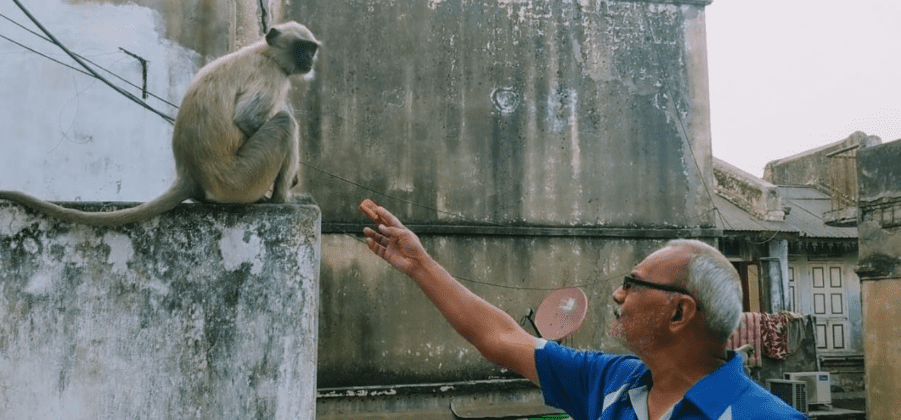

POLS OF AHMEDABAD: THE GATES THAT WELCOME ANIMALS
Like many, I grew up in a neighbourhood where street dogs were not welcome. They were often seen as the enemy and the residents would bar their entry fearing attacks, especially on their children. They were also perceived as “dirty” and carriers of diseases. There were even instances where a female dog was forcibly relocated along with its litter because it took refuge in front of one of the houses.
Animals living alongside humans in the urban setting is not a recent phenomenon. Interactions between urban wildlife and humans began ever since our species stopped living a nomadic lifestyle and settled down in one place. Many of these interactions within the urban setting have been viewed as negative and have led to conflicts, with many insisting that animals such as street dogs be completely removed from their vicinity. For example, as many as 40,000 street dogs were culled in Kerala in 2015, in light of the rise in dog bites.
It really shouldn’t be a surprise that these animals occupy the spaces built for humans. As the urban population grows, roads and concrete buildings encroach spaces that are inhabited by animals and cause a discontinuity in their living habits. Often, very little is done in terms of providing physical infrastructure to compensate for this fragmentation of space.
While these scenarios are typical of many urban settlements in India, there is a community that shows a way to peacefully coexist with animals. Despite its dense population, closely packed houses and narrow lanes, the Pols of Old Ahmedabad are setting an example for a harmonious coexistence between birds, animals and humans. The Pols, whose name is derived from the Sanskrit word ‘pratoli’ meaning ‘gate’, are a set of tightly knit neighbourhoods that emerged during the reign of Sultan Ahmad Shah in the 15th century. Through the centuries, the pols expanded in area and height to accommodate larger families and were strategically modified with secret passageways and guarded gates to provide protection and security during periods of social unrest. As a result of expansion, many areas suffered the loss of several trees and other natural habitats. Since birds and animals were and still are integral to the daily lives of the pol residents, due considerations were made to accommodate them within the built spaces.
The architecture of the houses has multiple elements that are sensitive towards animals and birds. For example, the outer facade of some of the buildings has small carved apertures and holes for squirrels and birds such as sparrows and parrots to nest while also providing them protection from larger birds. To compensate for the lack of trees, beautifully designed bird-feeders called Chabutras were made from carved stone and wood which can be found in the courtyards that attract birds such as pigeons, sparrows, and even squirrels. Along with the Chabutras for the birds and squirrels, most balconies are decorated with small bird-feeders and feeding trays that are replenished with grains regularly. Some buildings have eaves made of wood which make them ideal spots for squirrels to recline. Dogs and cattle can also be seen resting atop the steps found in front of these houses to get some relief from the heat and the rain as they provide a larger shelter area.
What makes the pols truly special, is the attitude of its residents towards their voiceless neighbours. The first roti prepared in their kitchens is reserved for the cows and dogs meandering through the lanes. The tribes of monkeys that are allowed to reside in some of the abandoned buildings are welcomed on the terraces every evening and are served food. Some residents even have special tins of biscuits reserved just for them. To ensure the continuity of this practice of nurturing animals, children are trained to mingle with the birds and animals from a young age. Perhaps, what has compelled the development of such a harmonious relationship, is the religious and cultural values of the pol residents.
The majority of the pol residents are influenced by the beliefs and traditions of Jainism that emphasizes that all animals are sacred and that they deserve to be treated with compassion and respect. Some believe that feeding cows help in driving suffering and pain away while offering grains for birds would boost their business, They also believe that preparing rotis for dogs can keep enemies away. However, some residents also find themselves conflicted about taking care of animals.
“It is both virtuous and sinful to take care of animals. The squirrels we feed become easy prey for crows and cats,” says one of the residents. Also, ever since Ahmedabad was declared a World Heritage City, there is pressure from the city authorities to keep the pol surroundings clean which has led to some of the residents restricting animals from entering certain areas. “They dirty the place. We need to stop feeding the animals to keep the neighbourhood clean,” she adds. These observations were made thanks to the site visits carried out as part of the Live-Action Project and Visual Communication module at Anant Fellowship in Anant National University.
Some amount of conflict posed by animals is here to stay. Nevertheless, the positive experiences with the urban wildlife far outweigh the negative and the pols remain a model for the rest of the ever-urbanizing world to draw inspiration from.
-By Shweta Jayasree